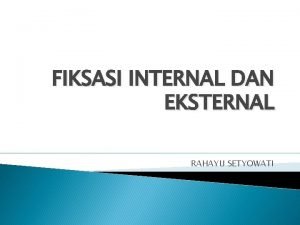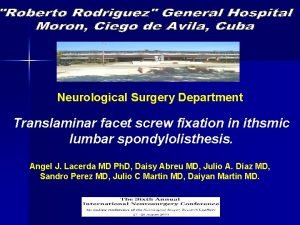SYNDESMOTIC SCREW FIXATION IN TREATMENT OF TRIMALLEOLAR FRACTURES

- Slides: 1

SYNDESMOTIC SCREW FIXATION IN TREATMENT OF TRIMALLEOLAR FRACTURES ID 23200 Dmitrijs Grigorjevs 1 Igors Terjajevs 1, 2 Mārtiņš Malzubris 1, 2 1 Rīga Stradiņš University, Latvia 2 Hospital of Traumatology and Orthopaedics, Latvia Introduction Results Fractures, that involve the fibula, medial malleolus and posterior edge of the tibia are fractures with distal tibiofibular syndesmosis injury. It would be logical to suppose, that in this cases when the posterior tibial fracture was not fixed, additional syndesmosis fixation would enhance stability and can help to achieve a better functional postoperative result. In practice, tibiofibular syndesmotic screw is inserted only if intraoperative stress examination (e. g. hook test) of the syndesmosis injury were positive. The mean age of patients in the group with TFS screw was 53, 31 (SD 14, 84) and in the group without TFS screw 55, 5 (SD 12, 64) years, p=0, 497. The mean duration of follow-up was 25, 75 (SD 3, 36) months in the group with TFS screw and 24, 5 (SD 3, 25) months in the group without TFS screw, p=0, 789. Patients were similar with regard to the median percentage of the tibial plafond involvement, p=0, 689. The mean loss of range of motion for ankle extension were 51, 01 (SD 28, 35) % in the group with TFS screw and 44, 65 (SD 21, 68) % in the group without TFS screw, p=0, 29. The median loss of range of motion for ankle flexion were 16, 67 (IQR 4, 8237, 95) % in the group with TFS screw and 5, 84 (IQR 3, 217) % in the group without TFS screw, p=0, 113. There were no significant differences in the SMFA scores. Figure 1. Postoperative X-rays of trimalleolar fractures ( AO/OTA 44 B 3. 2): A- with TFS screw fixation B- without TFS screw fixation Aim To evaluate the benefits of tibiofibular syndesmotic (TFS) screw fixation in trimalleolar fractures, when fracture of posterior edge of the tibia is not fixed. To compare functional midterm patients outcomes in the cases with tibiofibular screw fixation versus without. Figure 2. The loss of range of motion for ankle extension Materials and methodes From January 2016 to December 2016, patients with trimalleolar fractures (AO/OTA fracture classification 44 B 3. 2, 44 B 3. 3, 44 C 1. 3, 44 C 2. 3, 44 C 3. 3), which were treated in Hospital of Traumatology and Orthopaedics (Riga, Latvia) were identified. Excluding criteria was additional acute or previous fracture to ipsilateral lower extremity. Including criteria was surgical stabilization of malleolar fractures, where posterior tibial edge was not fixed. TFS screw was inserted only if intraoperative stress examination of the syndesmosis injury were positive (hook test). Eighty patients were eligible for the study and 30 chose to participate. Patients were followed up in 2018: examination consisted of goniometric motion assessment of both ankle joints, self-administered Short Musculoskeletal Function Assessment (SMFA). The AP and LL X-ray views of the ankle joints were analyzed. We divided patients in two groups- 16 patients with TFS screw and 14 patients without TFS screw have been removed at all patients in the group with TFS screw before follow-up time. Descriptive and analytical statistics (T test, Mann-Whitney test) was performed by IBM SPSS software. Significance was considered with p<0. 05. Figure 3. The loss of range of motion for ankle flexion Conclusion The functional postoperative results are similar in both groups. The decision to fixate syndesmosis should not be based only on fracture type. The intraoperative stress examination of the syndesmosis is currently the best way for determining the need for syndesmotic screw fixation.

